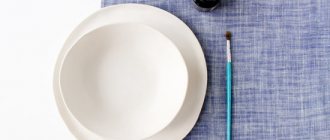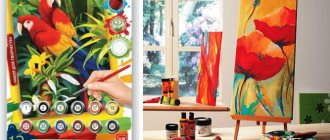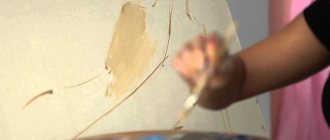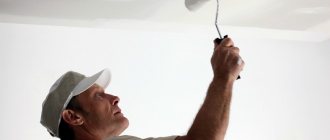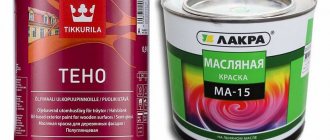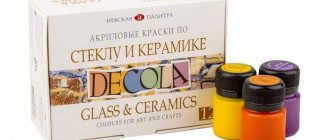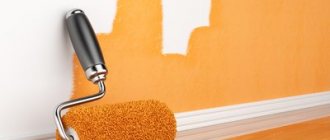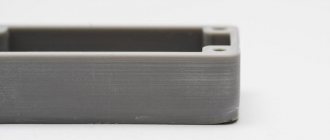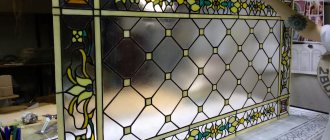Preparing the surface for painting
Wall decoration with painting or individual color elements is carried out on a flat surface. A concrete wall without a previously plastered surface will not work, just like walls with remnants of old paint or partially removed wallpaper. Otherwise, the drawings will simply fall away from the walls, forming a bubble base.
The minimum work that needs to be done on the wall before painting is:
- cleaning the surface from paint residues, wallpaper, uneven surfaces;
- leveling with plasterboard and putty;
- grout;
- primer.
After the work has been completed, they begin subsequent manipulations to decorate the walls with painting.
Acrylic primer creates invisible surface protection, penetrates 5-10 cm deep, and provides high-quality adhesion of materials over the primer. Depending on the requirements for the final work, a strengthening or deep acrylic primer is chosen.
Acrylic paints
Painting on the wall with acrylic paints is the best option due to the material’s resistance to direct sunlight. It is worth noting the following advantages:
- the ability to give the pattern a matte deep shade or a glossy solemn shine;
- the composition does not release harmful toxic compounds into the air even at a temperature of +50-60 degrees;
- the paint is resistant to fading;
- patterns can be washed with water;
- acrylic protects walls from damage by forming a thin film and resists moisture absorption.
An interesting option for wall decoration is painting with acrylic fluorescent or luminescent paints. Such compositions glow in the dark and are used both for children’s rooms and for decorating walls in the hall or hallway.
Is it possible to paint a wall painted with water-based emulsion?
Modern apartments with old renovations are in most cases painted with water-based paint, and therefore, when it is not possible to make major repairs, the question arises about the advisability of using a pattern on water-based paint.
Painting can be used on walls that were previously painted with colored or white water-based emulsion.
The only requirement is a flat surface without bulges or irregularities. You also cannot use decorative designs with patterns on wallpaper. Over time, the paint will swell, peel off, or deform the paper or vinyl base.
Preparing the wall before decorating
Before you start painting the walls, you need to prepare the surface. To do this, you need to remove the old coating (wallpaper, paint, whitewash or plaster). After this, the surface is cleaned and primed.
Then the wall is leveled. Apply the appropriate type of plaster, filling large cracks with it. When the composition dries, the surface is cleaned using sandpaper, and then the dust that is formed during this procedure is removed.
The prepared surface is treated with a primer, most often acrylic, to improve adhesion to the paint layer. The primer is also needed so that the applied image can be fixed, preventing its further shedding.
When choosing a primer, consider the indoor conditions. For example, for the kitchen or bathroom with high humidity, special compounds are used that are resistant to water and steam and contain antibacterial additives. Acrylate solutions can be used in dry rooms. The base coat of paint is applied only after the primer has dried.
What you need to paint walls: list of tools
The list of tools depends on the method used to apply patterns or designs. If you plan to draw using stencils, you will need:
- stencil blanks (disposable or reusable);
- roller;
- masking tape;
- thin brushes;
- dye;
- varnish or fixing base;
- 2-3 containers of different sizes;
- a bucket of water;
- hard cardboard;
- scissors and stationery knife;
- clean towels or sponge.
For work without using stencils, you will need the same set, with the exception of the first point. Additionally, you can use three-dimensional overlay patterns that give the picture integrity and realism.
Main production stages
So, first of all, you need to decide on the following aspects:
- where the painting will be located, where it will look most appropriate;
- the master must clearly set himself the goal of highlighting or emphasizing this or that spatial zone (for example, a good option could be to disguise some kind of construction defect with the help of this artistic technique, or, on the contrary, to draw attention to a striking architectural device);
- selection of the source image from which the painting will be made;
- preparation of consumables, in particular the choice of paint and brushes;
- background organization.
It is important to take these points into account, since the correctness of their implementation will affect the final result, which will be very difficult to change later.
What colors are used in the apartment?
Wall painting is used indoors and outdoors. However, if you decide to use the technology inside the room, it is worth considering in more detail the options for the most practical paints for the job.
Without smell
Painting walls in a room is a creative solution that allows you to decorate a room with new emotions, add individuality, add playfulness and beauty. However, in order to please not only the result of the work, but also the service life of the painting, it is necessary to choose coloring compositions that are odorless and have no harmful chemical compounds.
In total, several options for coloring compositions are used to apply a picture or pattern in a room:
- Acrylic with a high degree of adhesion and resistance to sunlight. Used for drawing in children's rooms, bathrooms, halls and other rooms where a creative composition is needed. Acrylic paints are divided into organic and synthetic. These paints differ in their color palette. Organic - with light shades without bright tones. Synthetic - on artificial resin, used to create designs in bright colors. Both compositions do not cause harm to the body, are odorless and dry in no more than 10 minutes.
- Fluorescent or luminescent paints are used to design part of the design so that the desired part glows at night. For example, a drawing on the wall in the form of an illuminated bridge over a river or city lights at night looks original and extraordinary. In the children's room, drawings with fairies and butterflies are used, which seem to come to life after sunset.
- Professional oil paints in tubes are used by specialists for painting on walls. In addition to experience and aesthetic taste, to perform such work you must have a certain level of professionalism. Drawings painted on the wall with artistic oil paints are realistic, and the pictures seem to come to life under the hands of the master.
The most popular artistic paints for wall painting are “Maimeri”, “Raphael” or “Ladoga”.
Painting elements and pictures with acrylic paints
The pattern on the wall of the room, made with acrylic paints, forms a thin film that does not allow moisture to penetrate and also helps protect the treated surface.
After 10 minutes of drying, the acrylic base forms a glossy or matte surface (depending on the type of composition), providing resistance to water, temperature and dampness. Stains that appear in the drawing are washed off with warm water, without cleaning compounds. If the task is to decorate a wall with natural shades or pastel colors (for example, for bedrooms), then it is recommended to use organic-based acrylic paints. For contrasting designs and patterns, it is better to use synthetic compounds based on artificial pigments.
For those who know how to paint on their own, it is recommended to buy clear acrylic paint and colors to create the necessary palette of colors.
Possible drawing options
At the moment, there are many techniques for applying a pattern to the surface of a wall. Mostly a brush or an airbrush is used as a tool; if experience allows, the tools can be combined.
Important! When creating a drawing with an airbrush, the image turns out to be similar to a photograph due to high-quality transitions between colors. A brush can't do that.
In order to create a large picture on the wall you need to work according to a certain algorithm:
- Draw a sketch of the desired image.
- Divide the entire area of the drawing into squares.
- Display the entire breakdown on the wall, indicating the squares. A laser level will help simplify this process.
- Transfer the previously completed sketch to the wall in accordance with the layout.
- The outlines of the drawing are painted with the selected color.
- Once the outlines are ready, color spots are applied to the elements of the design. The last image is given volume. The final stage is detailing.
- The finished drawing is coated with acrylic-based varnish. Usually they use a matte variety. It is used to protect the image from external influences.
This step-by-step approach will allow you to capture the image in its entirety and immediately remove any shortcomings that arise in the process.
If skill is not enough for professional painting, then a wide variety of templates will come to the rescue, which are now easy to find in any hardware store. They are also often made independently. To do this, the desired figure is depicted on thick cardboard or paper and then compacted. Afterwards the figure is cut out and becomes ready for use.
Important! To make a large-area drawing, you can use those stencils that are sold in stores or have them made to order from the appropriate company.
Choosing a stylistic direction
The drawing applied to the wall sets the tone for the entire space, and therefore it is important to choose the right stylistic direction that will help complement and embellish the room with the desired interior design.
For a bathroom, living room or veranda, paintings in the form of an open window, natural compositions using unobtrusive pastel shades are suitable.
For the hall, separate compositions are chosen that contrast with the main color palette on the wall of the room. Flowers and geometric patterns are popular.
For bedrooms and children's rooms, designs with calm shades and elements of luminescent paint are used, which accumulate light during the day and emit it at night.
Interesting ideas for painting
The main goal of creating a painting is to give the interior individuality. But this does not mean that any image will decorate the design. You need to choose the theme of the pattern or motifs taking into account the overall style.
For example, if the interior is designed in a loft style, then you can paint a brick wall in the living room or bedroom - it will be cheaper than using clinker for finishing.
Cityscape is a simple and unobtrusive solution for the living room.
Also, the drawings are selected taking into account the purpose of the room:
- Abstract motifs, ethnic patterns, and city landscapes would look appropriate in the living room. You can select an entire wall for painting and choose a pattern that, thanks to perspective, will create the effect of extending the space, visually enlarging the room.
- The bedroom is a place of relaxation. The room does not require detailed drawings; abstract paintings, floral and plant motifs are suitable. You can imitate various textures - natural stone, fabric, wood.
- Stories from your favorite fairy tales and cartoons are suitable for a children's room. There is no need to follow stereotypes, offering girls the color pink and Disney princesses, and boys - cars and airplanes. You need to ask the opinion of the occupant of the room. Perhaps a girl will like pirate themes and the romance of distant travels, while a boy will be attracted to cartoon animals.
For the kitchen, they traditionally try to choose still lifes. But it is unlikely that images of wine bottles, baskets of grapes or loaves are considered original and interesting. Landscapes, including those in vintage style, and various kitchen utensils are also used as motifs for kitchen painting, and vintage ones will look good.
You can decorate the walls of the room with images of lavender and herbs, lemon trees or coffee beans, folded into geometric patterns and ornaments.
Painting: step-by-step instructions for creating a drawing
There are many techniques for applying acrylic paintings to walls.
Among the most popular options is decorating walls with acrylic paintings. Master class on painting walls using acrylic paints.
- Apply a basic tone to the prepared surface, on top of which a drawing or pattern will be applied.
- Use masking tape to outline the side parts that you do not need to step on, as well as the plinth at the top (when applying a pattern up to the ceiling), and always on the bottom plinth to avoid contamination on this part of the wall.
- On the working surface of the wall, draw geometric shapes or other designs with masking tape. If you use oil art paint, make a rough drawing.
- Outline the shapes with paint, using a roller for a stencil pattern or a brush for individual elements.
- After the paint has hardened (after 10 minutes), remove the masking tape at an angle of 30-40 degrees.
- If necessary, apply sealer or varnish.
Advantages of artistic wall painting
Decorating walls of various types with drawings has many advantages:
- A quick option for changing or updating your interior.
- Variety of design types. Here everything is limited only by the imagination of the author himself.
- Long service life. If high-quality materials are selected, the painting will last for 15 years and will not lose its original appearance.
- Additional protection of walls by applying another layer.
If drawing is carried out by a master of his craft, then the result can be simply masterpiece. If you want to have a painting on the wall in a room, but there is no talent or desire for drawing, then it is better to use the services of a professional who, taking into account the wishes of the customer, will create the desired design.
Help for a beginner: stencils and blanks
It is easier to use prepared stencils with patterns and designs.
All you need is paint, a template, tape and time. Even a person without artistic talent can cope with the task. Apply the base color evenly, creating a working surface. Circle the side parts with masking tape. Fix the stencil in the four corners or stick it on the wall if it is self-adhesive. If the surface of the work is large, use a roller with thick but short fur; if there are individual elements, use a brush.
After applying the design, wait for the paint to dry and remove first the tape and then the stencil. It is important to wait until it dries completely, otherwise the paint will run or streak around the edges.
For beginners, it is better to use self-adhesive stencils. This way the design can be applied easily, without smudges or streaks.
Using wall paintings in the interior
The advantage of wall painting is its versatility of application. Drawings, well-chosen by theme, will be a worthy addition to the interior of any room in the house.
For a children's room, images of cartoon characters or fairy-tale characters would be an excellent design option.
A marine theme is appropriate in the bathroom interior, both landscapes and individual details in the form of funny dolphins or stylized jellyfish.
In the kitchen, wall paintings with an appetizing theme will be very appropriate. Beautiful still lifes or individual pictures on a kitchen theme will lift your spirits and allow you to make the interior of the room unique in design.
The hallway can be decorated with sketches on an architectural theme or images of animals.
The main condition for success is the correct selection of the pattern. It must be in harmony with the design of the room and correspond to the style of the decor.
The use of wall paintings allows you to make your living space especially cozy and unique in design.
Advice from professionals
A drawing on the wall is a work of art that attracts attention. To create a positive atmosphere in the room, you should take a responsible approach to the choice of shades, giving preference to stylistically correct design options. Tips from professionals to help you create a masterpiece on the wall:
- When painting a pattern on a stencil with a roller, apply re-painting after the first layer has dried;
- For volumetric textured designs, use 5-6 layers of paint in the right place: in the center of the flower, on the sides of the composition to give a 3D effect;
- When using paint aerosols, cover a large surface with masking tape, since the sprayer will stain the walls at a distance of 20-40 cm from the drawing.
The use of drawings for interior decoration is not a new direction. However, since the advent of photo wallpaper and wallpaper for walls, this design option was forgotten for some time. Today, the trend is returning again, and decorating a room with exclusive drawings allows you to express your creative ambitions and show an individual view of everyday things.
Paint selection
We will not get acquainted with the first production stages in detail, since everything here depends on the individual wishes of the customer (and, in the end, you can watch video master classes in which this problem is very clearly revealed). But it’s worth dwelling on the issue of paint selection in more detail.
And so, the most critical stage of the work is the selection of appropriate materials. The further operation of the object largely depends on how not only beautiful, but also how high-quality the paints are.
The most popular paints that can be used for working on wood, stone, etc.:
- Acrylic.
- Oily.
- Latex.
- Water-based.
The advantages, features of use and price of these materials are very diverse. Depending on what surface will be treated, how long it takes for the paint to dry, and what texture you plan to get in the end, you can choose the most optimal option.
Acrylic paints are the most popular, and this is not surprising, because they are easy to use, do not require long drying, do not spread during work and combine perfectly with each other, forming excellent tone transitions. They are moisture resistant and are not afraid of wet cleaning in the house and wet weather. Suitable for woodworking. Ideal for using spot-on techniques. Wash off with water solvents.
Oil ones are cheap and effective. Variations of color palettes are all possible. One drawback is that they take quite a long time to dry and at the same time emit an unpleasant odor. They are not afraid of wet weather.
Latex is an excellent type of paint that can be safely applied directly to the wallpaper. After drying, they form a thin film that protects the surface of the design from abrasion and moisture.
Water-based paints - these paints are rightfully called the safest and most textured. They are easy to apply and do not require additional care efforts. The only drawback is that they are applied only to a pre-painted wall with glossy paint.
To avoid subsequent troubles, you should take the choice of paint seriously.
Which of the above paints is best to use in a residential area? Acrylic and water-based ones are ideal; as for latex and oil ones, their use is possible only at the repair stage or in the case when it is possible to allow the material to dry completely after completion of the work (the smell released during the drying process can be toxic to the body, especially dangerous if there are children and pets in the house).
Acrylic paint is an excellent choice in all respects
Today acrylic paints are the most popular, and this is not surprising. They are used for working on wood, stone, plaster and other surfaces. It is equally good to use them in rooms with high humidity.
The advantages of choosing include:
- excellent thick texture that does not require the addition of water and therefore dries extremely quickly;
- do not fade when exposed to the sun;
- resistant to chemicals;
- the most vivid pattern that does not fade even over time;
- environmentally friendly product;
- After finishing the painting, the drawing is very easy to correct.
The main thing you need to remember is that acrylic paints are convenient and easy to work with. They are easy to combine, with their help you can easily create an amazing design both on wood and on a plastered wall. They perform well in a damp room (for example, a bathroom), and are easily washed off with water solvents.
Acrylic paints require special brushes, with the help of which the process of creating a special image will be carried out. You need to take brushes of different numbers, since to paint the walls it will be simply necessary to use several lines at once in size and thickness.
Acrylic paint is perfect for interior work, as it is non-toxic and easy to use.
An original method of creating a drawing on the wall with your own hands
What some people lack in creativity, they make up for with resourcefulness and ingenuity. There is one technical device with which you can easily decorate a wall with any design you like - this is a regular projector. You just need to highlight the image on the wall and outline all its fragments with a pencil - here you have a finished sketch! All that remains is to color it. Be sure to take note of this convenient technique.
Let's get down to business
Having decided on the choice of design, colors and technique, we move on to creating the image. We offer several options for different rooms.
| Room | Material | Example |
| living room | watercolor | purple orchids on a blank wall |
| bedroom | oil paint, pastel pencils | stenciled love tree |
| children's | tempera paint using fluorescent | cartoon characters or animals |
| kitchen | oil | fruit still life in warm colors |
| bathroom | any paint with a mandatory varnish coating | marine motifs |
Shall we decorate the rooms?
The landscapes in the apartment will look very beautiful
Living room
The choice of color scheme and theme depends on the overall style of the room. Black silhouettes of any kind you like are well suited for any color. They will fit harmoniously into cold and warm shades, without looking gloomy.
For a large living room, a watercolor painting on the entire wall would be an excellent option. Make it in cool, light colors to create a feeling of freedom and space, or use warm colors to create coziness.
An example would be a floral painting in purple or blue shades with the addition of green on a white background. In this room it is better to use hand painting.
For large rooms, you can make a large painting on the entire wall.
Bedroom
The help of stencils will be appropriate here. You can use them to create original patterns, making a photo frame that will be an excellent addition and a reminder to the couple of the wonderful moments spent together.
For the bedroom, it is recommended to use calm motifs and warm colors. From the cold range, gray, blue and light green are suitable. Add white notes, and a gentle, relaxing design is ready.
It is better to use calm tones in the bedroom
Children's
In this room, creative thoughts are allowed to be fully realized. You can create an original and fashionable design by inviting a master. Then you will get an abundance of bright colors and an accurate representation of the chosen theme. Having artistic talent, you will be able to independently depict your child’s favorite characters by decorating the entire wall.
If your talents do not allow you to create on a large scale, you have a chance to paint a wall with your child. To do this, use stencils or projector equipment. This choice will be a good opportunity to have fun together and let your child show his artistic abilities.
The children's room should have bright colors
How to create a pattern on wallpaper with your own hands. Learning from children
A classic children's prank is drawing on wallpaper. With the help of paint and his own fingers, the baby expresses himself. Did you know that some progressive masters have used this children’s fun as the basis of their creativity? From under our fingers scurrying along the wall, real masterpieces can emerge! Naturally, such an original approach to decorating walls in a room requires a certain skill, but who’s stopping you from trying your hand and consolidating your skills on a large sheet of whatman paper? The beauty of such creativity is that the drawings created directly with the fingers are unique, since it is very difficult to repeat something like this. Any non-toxic paint without a pungent odor will be suitable for the job. And remember the only rule of “children’s” creativity - do not put too much paint on your fingers so that it does not flow.
